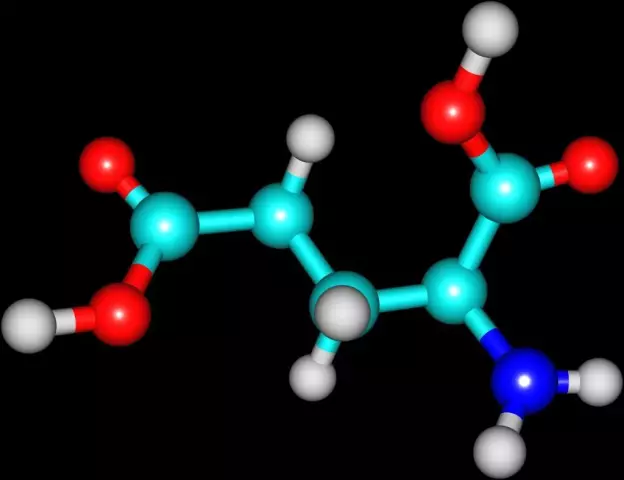- Author Rachel Wainwright [email protected].
- Public 2023-12-15 07:39.
- Last modified 2025-11-02 20:14.
Glutamic acid

Glutamic acid belongs to the group of nonessential amino acids and plays an important role in the body. Its content in the body is up to 25% of all amino acids.
On an industrial scale, glutamic acid is produced by microbiological synthesis. In chemically pure form, it has the form of odorless white or colorless crystals with a sour taste; crystals dissolve poorly in water. For better solubility, glutamic acid is converted into sodium salt - glutamate.
The use of glutamic acid
In the food industry, glutamic acid is known as a food additive called E620. It is used as a flavor enhancer in a number of products, along with glutamic acid salts - glutamates.
Glutamic acid is added to semi-finished products, various instant products, culinary products, broth concentrates. It gives food a pleasant meaty flavor.
In medicine, the use of glutamic acid has a slight psychostimulating, stimulating and nootropic effect, which is used in the treatment of a number of diseases of the nervous system.
In the middle of the 20th century, doctors recommended the use of glutamic acid internally in the case of muscular-dystrophic diseases. It was also prescribed to athletes in order to increase muscle mass.
The importance of glutamic acid for the body
The role of glutamic acid is difficult to overestimate, it:
- Participates in the synthesis of histamine, serotonin and a number of other biologically active substances;
- Neutralizes the harmful decomposition product - ammonia;
- Is a mediator;
- Included in the cycle of transformations of carbohydrates and nucleic acids;
- Folic acid is synthesized from it;
- Participates in the exchange of energy with the formation of AFT in the brain.
In the body, glutamic acid is a part of proteins, it is present in blood plasma in free form, and also as a component of a number of low molecular weight substances. The human body contains a supply of glutamic acid, in case of its deficiency, it first of all goes where it is needed most.
Glutamic acid plays an important role in the transmission of nerve impulses. Its binding to certain receptors of nerve cells leads to the excitation of neurons and acceleration of the transmission of impulses. Thus, glutamic acid performs neurotransmitter functions.
With an excess of this amino acid in the synapse, nerve cells can be overexcited and even damaged, which leads to diseases of the nervous system. In this case, the glial cells, which surround and protect the neurons, take over the protective function. Neuroglial cells absorb and detoxify excess glutamic acid in the brain and peripheral nerves.
The amino acid glutamic acid increases the sensitivity of muscle fibers to potassium by increasing the permeability of cell membranes for it. This trace mineral plays an important role in muscle contraction, increasing the strength of muscle contraction.
Glutamic acid in sports

Glutamic acid is a fairly common component of sports nutrition. It is a nonessential amino acid for the human body, and the transformation of other amino acids occurs precisely through the glutamic amino acid, which plays an integrating role in the exchange of nitrogenous substances. If the body lacks an amino acid, it is possible to compensate for its content by converting from those amino acids that are in excess.
In the event that the physical load on the body is very high, and the intake of protein from food is limited or does not meet the needs of the body, the phenomenon of nitrogenous redistribution occurs. In this case, the proteins that make up the structure of internal organs are used to build the fibers of skeletal and heart muscles. Therefore, in sports, glutamic acid plays an irreplaceable role, because it is an intermediate stage in the transformation of those amino acids that the body lacks.
Converting glutamic acid to glutamine for the purpose of neutralizing ammonia is one of its main functions. Ammonia is very toxic, but it is an invariable metabolic product - it accounts for up to 80% of all nitrogenous compounds. The greater the load on the body, the more toxic nitrogenous decomposition products are formed. In sports, glutamic acid takes over the reduction of ammonia levels by binding it to non-toxic glutamine. In addition, according to reviews, glutamic acid quickly restores the condition of athletes after competition, as it binds excess lactate, which is responsible for the feeling of muscle pain.
In athletes, with a lack of glucose levels at the time of intense physical activity, glutamic acid is converted into an energy source - glucose.
According to reviews, glutamic acid is well tolerated, has no side effects and is completely harmless to the body. Studies have shown that 100 g of protein food contains 25 g of glutamic acid. This amino acid is a natural component of animal food, and negative reviews about glutamic acid are somewhat exaggerated.
Found a mistake in the text? Select it and press Ctrl + Enter.






